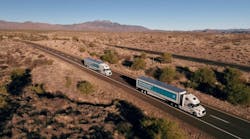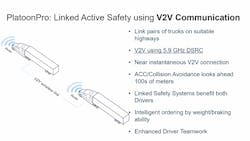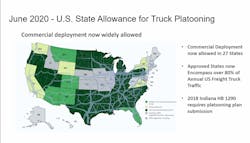One driver, two trucks? Paving the way to public automation acceptance
Fully autonomous, driverless trucks might one day be a vital link in the American supply chain. But that future still faces regulatory and public acceptance that is likely at least years away, if not longer.
An automated following system, however, where platooning trucks work together with a human-led truck, followed by an automated truck mimicking the tractor-trailer in front of it, could make drivers twice as productive while easing the U.S. freight industry into an autonomous future.
Peloton Technology CEO Steve Boyd said his company's auto-follow platooning technology does that while also making U.S. highways safer and Class 8 trucks more fuel-efficient as they cart freight across the country. The company's Level 1 PlatoonPro system, which has a driver in both trucks, began with seven fleets in 2018. The driver of the second truck steers, but the system controls the powertrain and brakes to manage the following distance. There have been no reported safety incidents in the trials, which have moved more than 3 million pounds of freight, Boyd said.
With the trucking industry struggling to find professional drivers, a human-led platoon with a Level 4 automated truck in the follow-position would make drivers twice as productive, Boyd noted during a Purdue University-hosted webinar on advancing driver-centric automation.
"The advantage of human-led automation with a lead human driver in the front vehicle is the ability to navigate more complex highway environments, the kinds of environments that are really what freight trucking requires to be dealt with every day: dealing with construction zones, traffic control situations, erratic drivers, weather changes, all the things that are much more challenging for an individual Level 4 driverless truck to deal with," Boyd said.
By platooning an automated truck with a human-controlled truck, some of the benefits of autonomous vehicles could get to market faster, Boyd said, while also meeting law enforcement and public expectations to interact with a human driver on roadways. "There's a big obstacle ahead for higher automation related to public acceptance, and absolutely regulatory acceptance, for sure," Boyd said. "Fleets that we talked to understand that the day-to-day trucking challenges they face mean you need a human in the loop."
Before the industry embraces a one-human-for-two-truck scenario, Peloton has been working with Purdue University and the Indiana Department of Transportation on building this next-generation platooning future for trucking on more geographically diverse freight routes, including hilly terrain. These platooning technologies — tested with a human driver in each cab — include:
- Coordinated shifting
- Variable speed setpoint cruise control
- Long-horizon predictive cruise control
- Constant platooning gap setpoint control
- Variable platooning gap setpoint control
Boyd is excited about the early work already completed on this collaboration, which he said has already improved the platooning systems with "smart powertrains working together and making platooning more effective on hilly terrains and deployable over broader kinds of operating environments on the highway."
Human-led automation with driver-assist technologies that can be deployed now is part of a practical road ahead for freight, Boyd argued. This sort of automation, he noted, would also lead to safer roadways, which is a top mission of the industry.
"The safe and efficient movement of freight over our highway system is critical to our national economy," said Greg Shaver, a mechanical engineering professor at Purdue University. "Each year in the United States, trucks transport well over $10 trillion in freight, and truck crashes cause more than 116,000 injuries to occupants of large trucks and other vehicles."
For now, both trucks in a platooning system would have human drivers, but both vehicles would benefit from being connected. "The first building block is making sure that each truck is safer all the time — everywhere it goes," Boyd explained. "Then, with connectivity, we put the safer trucks together, linking up and improving driver awareness, driver teamwork, and allowing the trucks to benefit from look-ahead safety of the lead truck, providing better awareness for the driver in the follow-truck. And that benefit of linked safety is near-instantaneous connection."
Trucks on today's roadways already tend to follow too closely, Boyd noted, in part to discourage passenger vehicles from cutting in between the heavy-duty vehicles. With platooning, the tractors would be able to operate even closer to each other, which would have the added benefit of reduced wind resistance on the follow-truck and better fuel efficiency. It would also discourage cars from cutting between the trucks. The seven fleets using the PelotonPro system averaged just one cut-in every 620 miles.
"And this is all at Level 1 automation, where the drivers in both vehicles remain fully engaged and steering at all times using the best of the driver-assist systems and the connectivity to improve that teamwork and shared safety," Boyd said.
The Peloton system uses "always-on" radar sensors to detect stopped or slowed vehicles hundreds of meters down the road to alert the driver and apply the brakes if needed. Connected trucks use vehicle-to-vehicle (V2V) communications, which allows the rear truck to react immediately to the front truck's actions. This communication allows the vehicles to accelerate and brake together and keep a proper and safe following distance.
Boyd also noted that independently evaluated system testing has shown over 7% combined fuel savings across truck pairs: approximately 10% for the following truck and 4.5% for the lead truck. Recent customer fleet trials have shown more than 8% average savings across pairs of trucks in regular freight operations.
“Cummins-powered PlatoonPro-enabled Peterbilt 579s trucks are in the process of being tested at highway speeds on hilly terrain in southern Indiana," according to Shaver.
Shaver said the Peloton system can estimate the mass of both vehicles in the platoon along with which truck has better brakes. "You always put the better braking truck in the rear," he said, adding that none of the testing or simulations have found a problem with different cargo weights in the platooning trucks.







